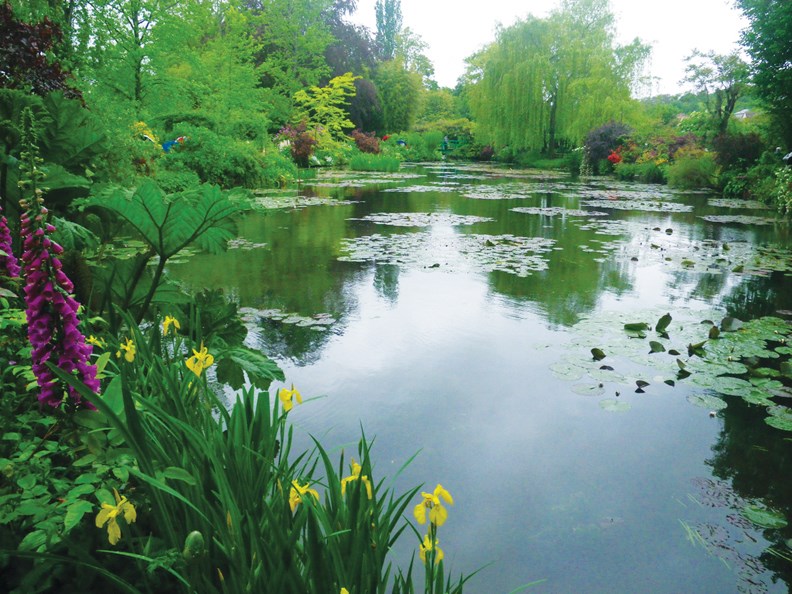As Viking Rolf’s first port along the river Seine, Vernon proves ideal for visiting Monet’s nearby home and gardens. And boarding a motorcoach with shipmates, we’re soon bound for Giverny.
Passing hillside pastures, guide Monique points out grazing Normande cattle. “Monet avoided landscapes featuring these pretty brown cows,” Monique grins. “He preferred churches, often travelling to nearby Rouen to paint its glorious Cathedral.”
Pointing out assorted stone buildings, Monique leads us into the small village of Giverny. Cafés, souvenir shops, art galleries and greenhouse nursery suggest a thriving tourist economy. We learn that the mayor himself created the town’s pleasing floral displays.
Signage directs us toward Monet’s renowned gardens. The paved path tunnels under a roadway and winds up along a lofty thicket of bamboo. Weaving through a wall of greenery, we arrive at the huge pond that inspired many of Monet’s masterpieces. Red azaleas, purple lilacs, orange columbine and pink foxgloves line the looping pathway.
Teeming with budding water lilies, the silvery pond mirrors floral splendour. Far eastern species, including yellow irises, enhance an oriental flair. Two green moon bridges span the waters. Framed by an arcade of draping wisteria, shipboard acquaintances enjoy posing atop one bridge.
Back through the underpass, we check out the more traditional garden. “As Monet continually sought new patterns of flowers for canvases, his gardeners utilized greenhouses to continuously replant the gardens,” Monique explains. “The site’s head gardener maintains this practice, providing visitors with nine months of radiant beauty.”
Roses bloom in profusion, perfuming the air. Their elegant pastels heighten the kaleidoscope of irises, poppies, daisies, peonies, hollyhocks and other spring flowers. Monet’s green-shuttered, pink farmhouse lies picturesquely on the hillside.
Leaving the adjoining gardens, we enter Monet’s turn-of-the-century home. Every room features windows open to fully enjoy the vibrant and fragrant gardens. A variety of fine art decorates the walls. Several rooms display his large collection of woodblock prints. Popular at the turn-of-the-century, Japanese art also influenced artists of that era.
Inside his high-ceilinged studio, lofty windows provide natural lighting. Sofas seem positioned for guests to watch him work. Replicated canvases fill two spacious walls. A self-portrait conveys eyes sparkling with creative intensity. His luminous Rouen Cathedral: The Portal epitomizes one of his 30-plus renditions.
Water fascinated him, so he often chose marine subjects. My favourite, Boating on the River Epte, represents one of his early Parisian river scenes. Two paintings of water lilies flank a table displaying photos of a white-bearded Monet sporting a straw hat and favourite model, his beloved wife Camille. In the famed Woman with a Parasol, he pictured her with their son on a park outing. He also portrayed her in a beautiful red kimono as Madame Monet en Costume Japonais.
The spacious lemon-yellow kitchen is set up for entertaining guests. A fireplace and cast-iron stove were used for cooking. An opposite white and blue tiled fireplace provided extra warmth. Twelve wooden chairs surround a long table, perfect for accommodating his two sons’ families or a cadre of friends.
Our brilliant day ends in the ship’s lounge at Monique’s insightful presentation on Monet and impressionism. “Development of ready to use tubed paints allowed artists to work easily and quickly outdoors. This innovation encouraged truer perceptions and spontaneity,” she explains. “This new art style was named after Impression, Sunrise, Monet’s hazy seascape of his hometown, Le Havre.”
We learn he lost Camille to cancer in 1879 and moved to Giverny four years later. He continued painting here until his death in 1926. Claude Monet’s long active life resulted in his becoming the most prolific and successful impressionist.
See www.vikingcruises.com for itinerary, riverboat accommodations, all-inclusive features and costs.



